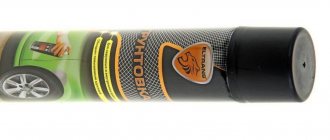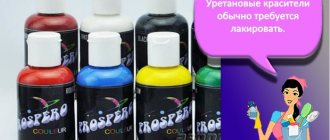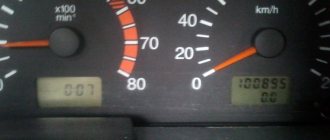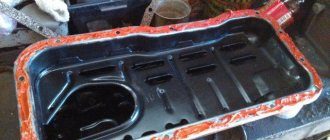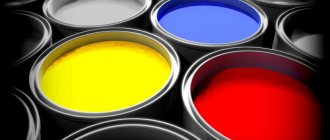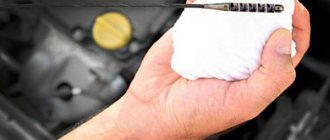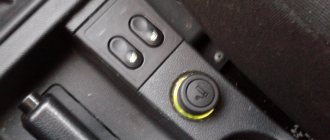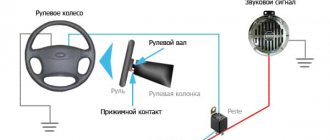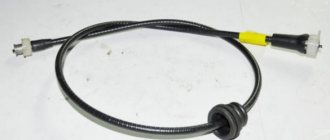Epoxy and acid primers
Recently, questions have often arisen regarding the use of various primers in body repair. Let's try to understand together what types of soils there are and in what case each of them should be used.
Compatibility of PRIMERS in car painting Acid and acrylic. Interaction of primers, their scope and compatibility.
We will highlight three main types of primers: - 2K acrylic filler or leveler - 2K epoxy primer - 2K acid primer As special ones, we will consider 1K epoxy-based etching primers.
Acrylic 2K primer performs only a filler function and can sometimes be an insulator of one layer from another. As a rule, such soils are hygroscopic. (Hygroscopicity - vapor permeability). They do not absorb water like a sponge, but only accumulate evaporation and moisture, which then condenses upon cooling and accumulates in the form of microdrops on the surface of the metal under the ground. And this moisture evaporates for a very long time, because of this the corrosion process begins on the metal. Therefore, acrylic primers are used only for filling/leveling (pouring) putty or underlying layers of paintwork.
Epoxy primers are used primarily as an insulator. Such soil does not allow water, evaporation, or moisture to pass through. Also, epoxy primer 2K or 1K is the primary primer when working with metals such as aluminum, zinc, copper, etc., as well as with cataphoresis primers, as it has excellent adhesion and acts as a waterproofing agent. Epoxy primer is chemically stable, but is sensitive to UV radiation, so you should not store your car in the open sun after applying only epoxy primer to it.
The third group of primers is 2K acidic primers based on polyvinyl butyral. They are also called phosphating or reactive. These primers provide chemical adhesion and also contribute to the formation of a protective layer on the metal. Often we are not able to remove rust completely. It still remains in the pores and microcracks. It is in this case that acid soil is used. It converts the remaining corrosion, turning it into a phosphate film, which will further protect the metal from oxidation. Also, as a result of chemical reactions, lead or zinc is deposited on the repair surface, which is present in acidic soil in the form of chromates. These metals practically do not oxidize and, accordingly, reduce the likelihood of corrosion at the repair site.
When working with aluminum, galvanized surfaces, as well as with cataphoretic primers, in principle, we can use both epoxy and acid primers, whichever is closer to you.
Now let's look at the pressing issue of soil compatibility. Acrylic filler primer can be applied to both epoxy and acid primers.
Acid primer can be applied to any 2K cured coating if it is not possible to apply it strictly to metal.
Epoxy primer, in turn, can be applied to any 2K cured materials. If old surfaces are undermined, this is a consequence of improper dilution, since we often use solvent 646 as a thinner, which is fundamentally wrong. You need to dilute it with your own special thinner. By the way, this is precisely what causes its incomplete drying. The 646th solvent, quickly evaporating, creates a surface crust, due to which the rest of the solvent cannot escape from the soil. As a result, we get “plasticine”, which has to be removed with a spatula. If the epoxy primer kit comes in a 1 to 1 ratio with a hardener, then such primers, as a rule, do not require additional dilution.
Epoxy primer, in particular, can be applied to 2K acidic ones. And we will consider this issue in more detail. So, I’ll say right away that you can apply it, but it’s not recommended. Nothing will fall off or peel off. But epoxy primer dissolves acidic primer, even if you did not dilute the epoxy with anything, and in this case the properties of the reactive phosphating primer are lost. So there is no practical sense. Some systems still provide for such a combination, but at the same time, the acidic one must be kept for at least one and a half hours. In a polymerized (irreversible) state, after matting it can be coated with almost any type of paintwork. But in our realities, we apply a thin layer of acid, since it is prone to strong shrinkage, so we do not have the opportunity to sand it, but cover it “wet-on-wet.” In turn, acrylic primer-filler is absolutely neutral to acid. So we can use acrylic as an insulator. It is applied to the acid layer in two complete layers, dried and matted in different layers, in accordance with what it will be subsequently coated with. If the next step is epoxy primer, then the gradation is P240 or P320, if putty, then P150 or P180. But then you ask, why putty? After all, it needs to be placed on bare metal? Putty should not be placed on metal if it has not been possible to completely remove rust. It is also prohibited to apply it to acidic primer, since its hardener, unsurprisingly, also dissolves thinly applied acidic primer. If you leave the acidic soil for more than an hour and a half, you can apply the putty, but again we must create a risk on the surface of the acidic soil, which is not possible, since we will simply erase it. In case of filling a problem area, first apply an acid solution, then cover it with two layers of acrylic filler, dry it, three P150 or P180. At the same time, try not to erase the acrylic primer along with the acidic one. Then we put putty. After processing the putty, we put epoxy on it in two partial layers with an interlayer of 5-7 minutes and after a 20-minute exposure we again apply acrylic in two full layers, which we then sand and prepare for painting. In principle, it is possible to paint over epoxy, but to do this we will have to dry it (up to 16 hours of waiting) and then sand it with difficulty, since it will be very hard. If it is painted “wet-on-wet”, which is also provided, then it must be applied in the most ideal way, which is often very difficult. It’s easier to cover it immediately with acrylic, since it’s easy to process, fills in small scratches and evens out a little.
What it is?
You should understand what acid soil is, then the principles and main tasks of using the substance will become obvious. Acid primer is a primer, sold in a can or as a liquid, consisting of phosphoric acid, sometimes with the addition of zinc, and is used to ensure better adhesion, valued for its anti-corrosion characteristics. The material is used for initial processing of car bodies.
Can only be used as a first coat; paints and varnishes cannot be applied over the acid primer layer. Protection against corrosion occurs due to the chemical properties of the product, unlike other primers with a mechanical protection principle.
A layer of such a composition cannot be treated with an epoxy composition, since the properties of the second layer neutralize the acidity.
To combat rust, acid primer is a powerful tool because it can completely destroy it.
The material has many useful properties that go beyond its anti-corrosion effect:
- thermal stability. High temperature does not have a negative effect on the substance;
- moisture resistance. The primer does not react under the influence of moisture and salt. The listed actions are especially important in winter, when there are a lot of salty mixtures and high humidity;
- protection from aggressive environments. The acid coating does not react in any way to numerous chemical compounds: oils, gasoline, etc.;
- weather resistance. The external conditions and operating environment for the machine are not terrible even without additional paint coating.
Expert opinion: acid or epoxy primer?
"Hi all! Not long ago, I again came across the question of which is better, acid primer or epoxy primer. As I understand it, this question periodically worries people involved in repairs.. But, first, let’s clarify xy from xy))) So!!!”
There are three main soils:
1) Acid 2K (etching, phosphating, reactive)
2) Epoxy 2K
3) Acrylic 2K
2K is a two-component material
Acid 2K primer
We use it on bare, clean metal, or with corrosion residues (in the pores, for example)
Acid soil is primary and in its finished form is a complex chemical substance. As a result of complex chemical processes occurring in the soil after its application, we obtain a section of metal coated (depending on the composition of the soil) with lead or zinc.
Acid primer has excellent adhesion to many substrates (aluminum, zinc, fiberglass, steel, etc.), and most paints and primers also have adhesion to it (but only when it is completely dry). Hygroscopic (that is, absorbs moisture)
Epoxy 2K primer
It is also primary. Applied to bare, clean metal without traces of corrosion. It has good “physical” adhesion and chemical resistance, and can act as an insulator when repairing old paintwork. Non-hygroscopic (that is, does not absorb moisture)
Acrylic 2K primer
Acts as secondary, repair primers. It is also an insulator for some coatings. There are filling and leveling soils (there are also universal ones). Applied to polyester (polyester) materials and substrates, as well as to old paintwork. Hygroscopic (that is, absorbs moisture)
Do not putty on acidic soil! He needs to be isolated. How?
Primary acid primer is applied in a thin layer as it is non-filling and has a low working residue. You can dry and sand it, but then it will be of no use because it will be sawed off during sanding. Therefore, it must be covered wet-on-wet. And it must be covered with acrylic primer, since it does not interact (does not react) with acidic primer, unlike epoxy primer, which reacts with acidic primer, causing the properties of the acidic primer to change and it loses its qualities.
The same thing will happen if putty with a hardener gets on top of the acidic one. From such a proximity, the acidic soil is dissolved by this hardener and all the original properties of the acidic soil will be irretrievably lost!
Conclusion.
The acidic primer must be covered with a wet-on-wet acrylic primer, then let it all dry, then fill it with paint and then apply epoxy primer or putty.
Now, in simple terms, why do I prefer epoxy primer... The answer is terribly simple, YES BECAUSE EPOXY IS NOT HYGROSCOPIC, in other words, epoxy does not allow or absorb water. An example is the fact that on icebreakers, epoxy is used as primer. The second advantage of epoxy is its strength and resistance to chipping. Let's return to the acid soil, it has its advantages, but no matter how good it is, acid soil is hygroscopic and, accordingly, allows moisture to pass through.
It makes no sense to write about the significant difference in the principle of operation of an acidifier as a “zinc” based on the polarity of metals and an epoxy as a stopping primer with the highest adhesion and strength. This is information for technical manuals and other literature that induces sleep))))! I think that I have indicated the most basic reasons for preferring epoxy.
Peace and success to all in your creative process.
What is the peculiarity of the composition
Acid primer for cars is a strong substance that ensures sufficient resistance of the frame to moisture and helps destroy rust. To completely remove rust before applying paint, it is recommended not to skimp on primer and buy a product from trusted brands.
The acid primer is based on phosphoric acid and a zinc additive. The product is applied exclusively as the first layer, that is, sprayed directly onto the metal. Before use, the surface must be degreased, this will help remove particles of rust and grease. Drying time at room temperature (20 °C) is 15 minutes.
When the composition has completely set, you need to additionally walk over the area with an acrylic primer. It helps to even out the layer. It is better to apply the composition to the seams with a brush. If you need to treat large areas, you should choose a spray bottle.
Acid primer is a mixture of phosphoric acid and zinc, it is primary and is sprayed directly onto the bare metal
Important! Do not apply the composition to old putty or poorly cleaned metal, otherwise the subsequent coating will peel off over time. Acid primer is applied only to clean, degreased metal; if there are old coating particles, you can use acidic epoxy primer.
In each case, the substance requires subsequent coating with a 2-component primer and filler. When high-quality preparation has been completed, you can begin coating with an additional layer of primer, putty and paint.
You cannot apply other compounds directly to the acid coating, the only exception being an insulating primer. Etching is a critical vehicle prep and treatment procedure to ensure metal integrity and corrosion protection. Welding seams are always coated with the substance.
What primer is used to prepare for painting cars?
Acid soil (reactive soil).
This is the so-called primary primer; it contains orthophosphoric acid (a rust converter). This type of primer is applied as the first layer to bare metal or old paint.
This is what the car looks like after applying acid primer:
It is not allowed to apply primer to materials with a polyester base (putties and their resins).
The primer provides excellent adhesion and anti-corrosion protection, but it must be over-primed with a two-component acrylic primer.
Painting directly onto acidic soil is unacceptable!
Epoxy primer.
As you guessed from the name, this type of primer is based on epoxy resin and perfectly isolates body metal from atmospheric air. Epoxy primer is applied to bare metal, old paint and putty (unlike acid primer).
This type of primer must also be covered with acrylic primer, although I painted metallic paint on it and there were no reactions.
Attention - this type of soil cannot be dried with infrared dryers; heating will soften it, flow and lose its properties.
Acrylic two-component primer.
The most universal primer used in body repair. For reasons of economy, acid and epoxy primers are extremely rarely applied to the body. We only do this on expensive cars! Usually the car is tinned, matted, puttied, matted again and primed with acrylic two-component primer.
This primer can be painted wet, matts quickly and easily, and has excellent hiding power.
Life hack - This primer can be tinted! If you tint the primer to the base color, paint consumption is reduced, and, most importantly, when chips and scratches reach the primer, they do not stand out on the car like this:
Primer for plastic.
Usually this is a one-component primer; it is an adhesion enhancer. Personally, we don’t use it for car repairs. We are used to matting the plastic bumpers with sandpaper with a score of 240-360, applying acrylic two-component primer, drying it, matting it again and painting it.
This is how to apply primer to a car body:
Review of primer manufacturers.
Worst primer or cheap and runny.
It so happens that the author of this article has been painting cars for many years, and if in the late 2000s Vika paint and primer from Yaroslavl ruled in terms of price/quality ratio, now this one is worth taking their primer only if you need to quickly paint a couple of parts and sell the car ….
The fact is that by buying a can of NOVOL, you will prime the average sedan. NOVOL soil is so thick that it will dilute 3-4 times! In the case of Vika, the can cannot be diluted even twice, since it is already very liquid. The result is that the price seems low, 400 rubles. at the time of writing, but in fact, due to the concentration, the primer will be more expensive than average manufacturers. And the quality leaves much to be desired... The simplest thing is that if you stick the electrode vertically into an open novol jar, it will remain standing; in the case of vetch, they can interfere with the soil without straining.....
A reasonable compromise is NOVOL.
Basically, in Russia novol is known as a Polish manufacturer of car putties, but in fact the list of their products is quite wide, and primer for cars occupies a fairly significant part of this list.
The soil itself is thick, has good hiding power, is easy to sand and, thanks to its thickness, shows one of the largest yields of product per jar...
The best budget solution is REOFLEX.
It so happened that for a very long time one of our friends worked as a sales representative for auto chemical goods. And the stars coincided that we got this particular soil at the lowest price. It was cheaper than vetch primer from retailers! And it so happened that our hands were filled with the soil of this manufacturer.
Types of acid soils for cars
There are 4 main groups based on composition:
- with one component. The composition is immediately ready for use, there is no need for preparation or preparation. Most often sold in a can for simple application of acid primer, but can be adapted for spray coating in 1 thin layer. When the material acquires the proper qualities, it is treated on top with acrylic with hardener additives;
- 2-component. Before use, you must prepare the substance; to do this, just mix it with the activator. The consistency of the product can be hard or soft. Professionals prefer hard options, as they result in a more durable film over the entire surface. Can be applied in 1, 2 or 3 layers, it is worth considering the recommendations of the product manufacturer. Between each application you need to maintain an interval of about 5 minutes in warm rooms;
One-component primer is ready to use - it does not require preliminary preparation
- reactive form. It is used to process pure metal coating; it forms a tiny layer (from 8 to 13 microns). The top also needs acrylic coating. It is the basis; the necessary layers are then applied to it;
- Self-Etch primer. Refers to the ingredients that make up the soil; it means a composition with the addition of zinc. Used to eliminate irregularities and improve the quality of grip. Initially, the acidic substance acts on the metal, causing a protective coating of frozen polymer products to appear.
Principles of use, maximum layer thickness and mixing methods are described for each product separately and may vary significantly.
Epoxy primers
Now let’s go back a little and look at the question of whether it is still possible to do body repair without etching primers.
It turns out that it is possible if, instead of an etching agent, you use an epoxy resin-based primer as the primary primer. Epoxy primer, like etching primer, provides the metal with excellent anti-corrosion protection, but its operating principle is somewhat different. If acid-containing primer protects the metal using a chemical reaction, then epoxy primer provides physical protection: thanks to its hard and fairly thick film, it reliably blocks the access of moisture and oxygen to the metal.
Both of these soils cope with their protective functions, although in different ways, but equally well. What then are the advantages of epoxy primer over acid primers? When and why to use it?
As you know, an acid-containing anti-corrosion primer can only be applied on top of the putty (to protect the bare metal around it), but not under the putty itself! But in this case, it turns out that there is no additional metal protection under the putty itself.
And then it is enough to have a microcrack in the metal, as water under capillary pressure tends to get under the layer of putty from the inside. And since the putty is hygroscopic, when it absorbs this moisture, it begins to swell, and after a while the freshly painted surface becomes covered with many ugly bubbles. That's how they painted it!
How to protect the putty from moisture from the inside? This is where epoxy primer comes to the rescue: first, a layer of epoxy primer is applied to the metal, and then putty is applied over it.
Epoxy primer is the only anti-corrosion material that can be applied under polyester putty - no more bubbles! This technology is used in top-quality painting systems; it allows you to extend the warranty on painted parts to seven years or more!
Epoxy primer not only has excellent adhesion to many different surfaces (galvanized, galvanized steel, aluminum and all its alloys, stainless steel, fiberglass), it is also a good substrate for coating enamels (thanks to its good filling properties and good spreadability). Therefore, you can cover the putty areas with a couple more layers of epoxy - and after sanding the part will be ready for painting. I note that this is not the only possible option in this case; read about the rest in the article on priming.
It is also recommended to apply liquid putty directly to the epoxy primer and cover it with another layer of epoxy - like a sandwich. This primer also works very well on fiberglass, and also as an insulator for old, problematic coatings.
And if you apply this primer to the edges and ends of the parts, you can forget about paintwork explosions and chips in these places, as well as their premature corrosion. After all, very often it is the ends of the doors that rust the fastest. This happens because modern paints and varnishes, in order to improve visual properties (reduce shagreen) must have a high surface tension coefficient. And this leads to the fact that the paint on the edges of the elements stretches, its thickness decreases.
Despite all the advantages, epoxy primers also have certain disadvantages due to their increased strength. This makes these primers more difficult to process than conventional acrylic fillers. For the same reason, epoxy primer can sometimes cause contouring in a spot repair.
In addition, the maximum application thickness of epoxy primers is significantly lower than that of acrylic primers, which requires a very high quality of surface treatment. Therefore, epoxy primer performs best when used as a primary primer, followed by application of a filler primer.
Preparing the body for priming
For a high-quality and durable coating on a machine, you need to use proven processing technology:
- Initially, preparatory work is carried out in the room where painting will take place.
- The surface is cleaned down to metal, removing remnants of old paint, dirt, dust, putty, etc.
- External inspection of the vehicle and selection of optimal enamel.
- Protection of vehicle parts that should not be processed.
- Degreasing metal, as well as grinding using an abrasive agent.
- Using putty.
- Formation of an anti-corrosion coating.
In the process of cleaning and degreasing work, it is better to use a brush; you can use an aerosol form. When using a spray can, the coating turns out much smoother, and it is easier to apply acid primer.
Primers for car refinishing
By analogy with the primers used on the conveyor, all primers for repair painting are divided into two large groups:
- primary - so-called primers (from the English prime - main, main),
- secondary - fillers (from the English fill - fill, fill).
The primers used in repair painting differ from those used at the factory (in the application method, drying modes, viscosity, surface preparation method, etc.). But the functions are exactly the same. Primary ones are needed to protect the metal from corrosion and ensure strong adhesion of the paint and varnish coating to the surface of the part. Secondary - for leveling minor unevenness of the painted surface, creating a uniform substrate for the enamel and protecting the paintwork from chipping.
There are primers that have the properties of both primers and fillers at the same time. Different materials are also used for application to metal and plastic.
But first things first. Let's start with primary primers for metal.
Acid Primer Application Methods
There are several methods for processing body elements:
- using a brush;
- by means of an aerosol;
- by complete immersion method, more often used for small elements;
- by spraying method under the influence of electrical energy;
- electrodeposition. The processing option involves the use of the principle of electrophoresis. The part of the body that needs to be painted is placed in the tank and is a charged link in the chain.
The total immersion method can only be used in production conditions.
Epoxy and acrylic compositions can be applied directly under the car’s painting - in fact, that’s what they are designed for
During any work using acidic agents, special protective methods should be used. If the substance gets on the skin or mucous membranes, damage may occur.
Primers are always applied before painting, but when it comes to sanding it is not so clear cut, in some cases sanding is used and in others it is not.
The main quality conditions are:
- using only high quality products;
- precise and correct compliance with technical measures;
- sufficient qualification of the master.
To prevent corrosion, polyvinyl-butylene is used, which is included in the formula of most materials. Cars and individual parts from:
It is prohibited to apply products consisting of polyester bases to the acid coating. It is recommended to proceed to further work 1 hour after treatment.
epoxy and acid primers
3 messages
Epoxy and acid primers
Recently, questions have often arisen regarding the use of various primers in body repair. Let's try to understand together what types of soils there are and in what case each of them should be used.
We will highlight three main types of primers: - 2K acrylic filler or leveler - 2K epoxy primer - 2K acid primer As special ones, we will consider 1K epoxy-based etching primers.
Acrylic 2K primer performs only a filler function and can sometimes be an insulator of one layer from another. As a rule, such soils are hygroscopic. (Hygroscopicity - vapor permeability). They do not absorb water like a sponge, but only accumulate evaporation and moisture, which then condenses upon cooling and accumulates in the form of microdrops on the surface of the metal under the ground. And this moisture evaporates for a very long time, because of this the corrosion process begins on the metal. Therefore, acrylic primers are used only for filling/leveling (pouring) putty or underlying layers of paintwork.
Epoxy primers are used primarily as an insulator. Such soil does not allow water, evaporation, or moisture to pass through. Also, epoxy primer 2K or 1K is the primary primer when working with metals such as aluminum, zinc, copper, etc., as well as with cataphoresis primers, as it has excellent adhesion and acts as a waterproofing agent. Epoxy primer is chemically stable, but is sensitive to UV radiation, so you should not store your car in the open sun after applying only epoxy primer to it.
The third group of primers is 2K acidic primers based on polyvinyl butyral. They are also called phosphating or reactive. These primers provide chemical adhesion and also contribute to the formation of a protective layer on the metal. Often we are not able to remove rust completely. It still remains in the pores and microcracks. It is in this case that acid soil is used. It converts the remaining corrosion, turning it into a phosphate film, which will further protect the metal from oxidation. Also, as a result of chemical reactions, lead or zinc is deposited on the repair surface, which is present in acidic soil in the form of chromates. These metals practically do not oxidize and, accordingly, reduce the likelihood of corrosion at the repair site.
When working with aluminum, galvanized surfaces, as well as with cataphoretic primers, in principle, we can use both epoxy and acid primers, whichever is closer to you.
Now let's look at the pressing issue of soil compatibility. Acrylic filler primer can be applied to both epoxy and acid primers.
Acid primer can be applied to any 2K cured coating if it is not possible to apply it strictly to metal.
Epoxy primer, in turn, can be applied to any 2K cured materials. If old surfaces are undermined, this is a consequence of improper dilution, since we often use solvent 646 as a thinner, which is fundamentally wrong. You need to dilute it with your own special thinner. By the way, this is precisely what causes its incomplete drying. The 646th solvent, quickly evaporating, creates a surface crust, due to which the rest of the solvent cannot escape from the soil. As a result, we get “plasticine”, which has to be removed with a spatula. If the epoxy primer kit comes in a 1 to 1 ratio with a hardener, then such primers, as a rule, do not require additional dilution.
Epoxy primer, in particular, can be applied to 2K acidic ones. And we will consider this issue in more detail. So, I’ll say right away that you can apply it, but it’s not recommended. Nothing will fall off or peel off. But epoxy primer dissolves acidic primer, even if you did not dilute the epoxy with anything, and in this case the properties of the reactive phosphating primer are lost. So there is no practical sense. Some systems still provide for such a combination, but at the same time, the acidic one must be kept for at least one and a half hours
Some systems still provide for such a combination, but at the same time, the acidic one must be kept for at least one and a half hours. In a polymerized (irreversible) state, after matting it can be coated with almost any type of paintwork. But in our realities, we apply a thin layer of acid, since it is prone to strong shrinkage, so we do not have the opportunity to sand it, but cover it “wet-on-wet.” In turn, acrylic primer-filler is absolutely neutral to acid. So we can use acrylic as an insulator. It is applied to the acid layer in two complete layers, dried and matted in different layers, in accordance with what it will be subsequently coated with. If the next step is epoxy primer, then the gradation is P240 or P320, if putty, then P150 or P180. But then you ask, why putty? After all, it needs to be placed on bare metal? Putty should not be placed on metal if it has not been possible to completely remove rust. It is also prohibited to apply it to acidic primer, since its hardener, unsurprisingly, also dissolves thinly applied acidic primer. If you leave the acidic soil for more than an hour and a half, you can apply the putty, but again we must create a risk on the surface of the acidic soil, which is not possible, since we will simply erase it. In case of filling a problem area, first apply an acid solution, then cover it with two layers of acrylic filler, dry it, three P150 or P180. At the same time, try not to erase the acrylic primer along with the acidic one. Then we put putty. After processing the putty, we put epoxy on it in two partial layers with an interlayer of 5-7 minutes and after a 20-minute exposure we again apply acrylic in two full layers, which we then sand and prepare for painting. In principle, it is possible to paint over epoxy, but to do this we will have to dry it (up to 16 hours of waiting) and then sand it with difficulty, since it will be very hard. If it is painted “wet-on-wet”, which is also provided, then it must be applied in the most ideal way, which is often very difficult. It’s easier to cover it immediately with acrylic, since it’s easy to process, fills in small scratches and evens out a little.
The last type of primer we will look at is 1K epoxy based etch primer. They come in both cylinders and liter jars. They are mainly used as primers “from rubbing” or “cutting”. Apply to exposed areas of metal or putty in 2 thin layers with interlayer drying for 4-7 minutes and after 20 minutes can be covered with most paintwork. They are also used as primers for multi-surfaces, this is when we have stains of various materials - metal, putty, primer, paint, etc. So we cover this entire farm with just such soil. In this case, they help reduce the risk of formation of such defects as delineation of the repair area and subsidence of materials. In general, it is recommended to use it in every repair, as an intermediate layer between putty and acrylic filler. Why? Because we often dilute the primer with a solvent, which is then absorbed into the putty, and, evaporating, can subsequently lead not only to the above defects, such as contouring or subsidence of materials, but also to peeling of the base or varnish. So make sure you always have it on hand.
What else do you need to know
You can often encounter a situation where workshop technicians suggest applying an acid base over the body as a preparation for painting. The technique is called Wash Primer. The consequence of priming with acid is the preservation of the characteristics of the composition for 2 days after mixing the ingredients. The material dries in 2 hours.
The acid layer is applied only after complete degreasing, checked using a clean cloth
The best results are obtained by sanding the reactive primer using a light-grit sandpaper.
The most popular primer is a group consisting of 2 components. A filler primer is applied on top of it; this is a mandatory overcoating procedure. With the help of an additional coating it is possible to increase wear resistance.
If you use such a product, you can completely stop the spread of corrosion throughout the body or prevent its occurrence.
The acid composition differs from other types of soil in the possibility of using grinding, but such a procedure may be prohibited if the body has defects.
How to prime with acid primer
The whole algorithm of actions is quite simple, not much different from standard soil:
- Complete cleaning of the base.
- Treatment with a degreaser or conventional solvent.
- Primer covering. You can use a brush, but it is only suitable for small areas. In other cases, it is important to use a sprayer. Excessive surface treatment should be avoided; 1 thin layer is sufficient.
- Wait 2 hours, during this period the chemical reactions will end.
- Application of standard primer.
If you apply a layer using an aerosol in a can, the coating will be more even than if you do it with a brush
Classification of soils in auto repair
Acidic soil
Phosphoric acid (a rust converter) is used as a chemical reaction catalyst for these soils.
That is why such soils are also called acidic or acid-containing, as well as reactive (because they enter into a chemical reaction with the surface). This type of primer is applied as the first layer to bare metal to protect against corrosion. It is also acceptable to use on rust remaining in cracks and pores after cleaning.
Applying primer to putties is not allowed.
The primer provides excellent adhesion and anti-corrosion protection, but it must be covered with a two-component acrylic primer.
Painting directly onto acidic soil is unacceptable!
Epoxy primer
Epoxy resin based primer. It has a dense structure and, by forming a film, perfectly protects the metal from atmospheric air and moisture, thereby preventing rust from developing. Epoxy primer can be applied to bare metal, old paintwork and putty.
Epoxy primer also acts as an insulator for the non-uniform repaired surface from aggressive solvents contained in paints and varnishes, and also provides good adhesion to both the repaired surface and the paint.
Despite their undeniable advantages, epoxy primers have disadvantages due to their increased strength. This makes these primers more difficult to process than conventional acrylic fillers.
Adhesive primer for metal (primer)
Primary adhesion primer often has anti-corrosion properties. The 1K primary adhesive primer + 2K primer-filler technology is traditional and recommended by classical auto repair schools. But in case of local repairs, painting directly with 1K low VOC primer is allowed. When working with bare metal, the use of primary primer is very important; it provides strong adhesion both to the surface of the metal and to subsequent applied layers of paintwork.
Areas of its application are areas of bare metal, places most susceptible to corrosion.
Apply in one thin layer and do not sand.
Adhesive primer for plastic (primer)
Such a primer, as a rule, is a ready-to-use transparent material with small additions of “silver particles” (to control application). The layer thickness is very small - up to 5 microns. Basically, such primers are universal and are applicable, if not to all, then to most types of plastics found in auto repair.
The use of this primer when repairing bumpers, mirrors, spoilers and other plastic parts of the car is necessary. Primer on plastic ensures adhesion between plastic and subsequent coatings.
Secondary soil is also a filler, it is also a foam filler, it is also a leveler. Performs a leveling function, hides pores and craters present on the putty, marks after sanding, and places where coatings transition.
Modern soils, as a rule, allow tinting. This allows you to select the tone of the primer as close as possible to the enamel and helps reduce the number of paint layers, which means reducing its consumption and reducing repair time.
All secondary primers can be divided into two types of application:
sanded and non-sanded.
Non-sanding
Designed for wet-on-wet performance.
Primers for painting using the “wet on wet” method are usually labeled as “Wet on wet”, “w/w”, “non sanding”. The main characteristics of “wet” primers are, firstly, excellent spreadability: they form a smooth surface suitable for applying enamels without preliminary grinding, and secondly, a minimum exposure time before applying paint. Such materials do not need to be dried in OSC; after a short exposure, topcoat enamel can be applied to the primed surface.
However, it should be borne in mind that wet-on-wet primers are more suitable for new parts, and for those that have been severely damaged, they may not be thick enough to level the surface well.
Many secondary primers, depending on the proportions of mixing with thinner, can be used with equal success in either sanded or wet-on-wet versions. Such primers are more universal, and the most modern of them allow you to have one primer not only for retail application methods, but also for various substrates - OEM metals and plastics,
Sandable
Classic sandable primer filler
Standard filler primers are applied in 2-3 layers, providing a total coating thickness of 100-180 microns. In most cases, this thickness is quite sufficient.
Thick-layer (high build)
Thick-layer soils allow you to achieve greater thickness up to 250-300 microns. Such products are convenient to use for complex restoration repairs, when large areas and entire damaged parts are repaired.
Soil in aerosol
A one-component primer-filler, available in aerosol cans. Practical packaging with the finished product and due to its ease of use has earned the love of car painters. Primer in cans is used in cases where, when preparing a part for painting, the primer was rubbed down to the metal during sanding. In this case, aerosol primer allows you to save material, as well as time that would have to be spent on diluting the primer, filling it into the gun and washing it after work. This soil does not need to be dried in USC and has a long shelf life.
Application of primers in car repair:
Share:Examples of acid primers (grades)
You can choose the best acid primer only taking into account the individual characteristics of the car, but often preference is given to:
DUR 1:1 (reactive primer with phosphate)
The manufacturer DUR has achieved rapid acquisition of strength, a high degree of coating reliability and excellent adhesive properties. A positive quality is the absence of chromate among the ingredients. To speed up curing, a reaction catalyst is used, it is included in the kit. Sold in the form of a gray liquid in 1 liter containers.
Body 960 Wash Primer
It is a 2-component primer, it has a yellow color and is used to coat stainless, galvanized, aluminum and galvanized materials. Before use, you need to mix the product with the hardener, and then the mixture is applied to the metal surface with a layer of 10 microns. Drying time is 10 minutes.
After application there is no need for sanding, only a leveling layer, which can be any two-component material, with the exception of polyester.
Mobihel
Belongs to a one-component group. It is gray in color and has high anti-corrosion properties. Can protect steel, galvanized and aluminum.
The chemical properties of the material serve as a very effective prevention against rust and protect the material from the effects of salt and moisture.
The product is used as follows:
- The soil is mixed with the diluting liquid in a ratio of 5 to 1.
- The surface is prepared using fine-grained material.
- Spray in 1 layer using a spray gun, setting the nozzle to 1.3.
- Wait 1 hour for hardening, sanding is no longer needed, you can immediately treat it with primer, paint and varnish.
Radex CR 1+1
The primer is good at etching metal to protect it from corrosion. Consists of 2 components: main liquid and hardener. Both formulations are sold in 1 liter containers. Before work, you need to mix both ingredients in a 1 to 1 ratio.
Professionals recommend the product for processing brand new steel body parts and for repair work on aluminum, steel and galvanized steel. The advantage is strong adhesion that prevents corrosion.
Reoflex 2K 1+1
Consists of 2 components: yellow primer with a phosphating component and a hardener. It is used to restore damaged coatings, but can be used for new parts. Hardening time is 15 minutes, temperature is 20 °C. Recommended layer thickness is 10 microns.
Advantages and disadvantages
The properties of an acid primer are considered its advantages. These include:
- high degree of wear resistance;
- enormous resistance to moisture and salt compounds;
- reliable protection of the material from external negative influences;
- excellent heat resistance – at high temperatures the qualities of substances do not change;
- fast hardening – within 5 minutes;
- resistance to the destructive aggressive influence of petroleum products, such as engine oils and gasoline.
In addition to numerous advantages, there are also disadvantages of the material. For example, it burns well. In addition, it is toxic, and when working with it you must work carefully and avoid contact with the skin and eyes.
The product cannot come into contact with paint coatings and epoxy primers.
Acidic, phosphating, etching or reactive primer?
All these names, one way or another, refer to soil that contains acid. In English, there are three different names for acid soils, which are also indicated on packages sold in Russia. Etch or etching primer - etching primer, self etch/etching primer - etching primer, which has ingredients that immediately after the action of the acid are eaten into the metal, creating anti-corrosion protection, wash primer - reactive primer, which also contains acid and, in theory, is intended for application to new metal that does not contain old putty and paint to increase adhesion (especially non-ferrous metals, such as aluminum).
p, blockquote 4,0,0,0,0 —>
Some acidic soils are not “strong” enough to attack steel. You need to look at the technical specifications of the product.
p, blockquote 5,0,0,0,0 —>
Different manufacturers have different primer formulas and instructions for use. Initially, etching primers did not contain components that increase corrosion protection and, especially, fillers that fill small irregularities. Nowadays you can find acidic soils from different manufacturers that contain anti-corrosion additives and can be used as fillers at the same time. Most often, however, a good acidic primer is able to chemically act on any metal, preparing it for the next layer of filling primer, and also converts a small amount of difficult-to-clean rust and passivates the surface of the metal, making it inactive to oxidation, and therefore to corrosion.
p, blockquote 6,0,0,0,0 —>
Wash primer
Wash primer and acid primers are similar in their action. Wash primer is applied only to bare metal. It does not fill in scratches and minor irregularities and requires the application of acrylic primer on top of it. Wash primer is phosphoric acid in a solution of polyvinyl butyral polymer, isopropyl alcohol and other ingredients. This primer is applied in a thin layer, creating a dry film 8–13 microns thick. This primer makes the painting process more efficient and adds anti-corrosion properties to the metal. In the future, during operation, even with slight damage to the paint layer, the metal treated with reactive primer will not rust.
p, blockquote 7,0,1,0,0 —>
This primer passivates the metal before applying the filling primer. The metal surface becomes inactive to oxygen contained in air and water. A very thin film is created, it goes into a passive state, and corrosion processes are inhibited. It also creates a good base for applying the next layer of filling primer.
p, blockquote 8,0,0,0,0 —>
Wash primer is usually recommended for use on aluminum and other metals to improve adhesion followed by coating. On aluminum and galvanized metal, without preparation with this primer, the coating does not adhere well.
p, blockquote 9,0,0,0,0 —>
Self-etch primer
If the package says Self-etching, then this is a filling acid primer with the addition of zinc. The acid corrodes the metal, and the zinc immediately eats into it. The acid is usually phosphoric acid. Self-etching primer is designed to improve adhesion and smooth out uneven metal surfaces. This primer phosphates and primes the surface at the same time. First, a chemical reaction of the acid with the metal occurs, and then the polymer and anti-corrosion pigments form a protective film when dry.
One-component acid primer
One-component acid primer does not require the addition of an activator. This primer is sold both for application with a spray gun and in cans.
p, blockquote 10,0,0,0,0 —>
p, blockquote 11,0,0,0,0 —>
Acid primer contains no fillers and dries to a very thin layer.
p, blockquote 12,0,0,0,0 —>
One thin layer is enough. Applying a thick layer or several thin layers of a one-part acid primer will not make it more effective.
p, blockquote 13,0,0,0,0 —>
It must be remembered that any one-component product is in an unstable (unhardened) state and can affect the next layer of coating. Immediately after drying, the acid primer should be coated with a two-component (with hardener) acrylic filler primer.
p, blockquote 14,1,0,0,0 —>
Primary primers (primers)
Primary primer is also etching, it is anti-corrosion, it is also adhesive. Areas of its application are areas of bare metal, places most susceptible to corrosion.
Such primers have excellent adhesion to metal, because we must not forget that in addition to the protective primer, the primary primer performs another important function: it serves as a kind of adhesive intermediary, ensuring strong adhesion both to the metal surface and to subsequent applied layers of paintwork. Therefore, replacing this material or eliminating it will be similar to building a house without a foundation.
Ensuring good adhesion is only half the task that primary primer solves. Its anti-corrosion properties are no less important.
It would seem that today, when most cars are painted using a two-layer technology (base + varnish), where the varnish layer is durable and waterproof, anti-corrosion primer is not so necessary.
Indeed, if you paint an iron fence with modern car paint, the metal will remain preserved for many years. But you and I are not painting fences, but cars, and with them the situation will be more complicated.
The fact is that the thin steel sheets from which car bodies are made are subjected to constant mechanical stress and alternating loads during operation, especially at joints. And since the top layer of varnish must be quite hard to avoid abrasion, sooner or later microcracks will appear in it. Gradually developing deeper, these microcracks reach the surface of the metal.
Then it’s a small matter: moisture penetrates the metal and a terrible red smudge appears on the surface of the paintwork, seemingly undamaged... And if such a place is sanded, a pocket of rust up to several centimeters in size will be revealed.
Things will be completely different when using anti-corrosion primer on bare metal. Now the development of the crack will stop at its border, since cracks do not form in the soil itself - due to its very small application thickness (about 10 microns).
But an attempt to apply a thick layer of anti-corrosion primer, on the contrary, will lead to a decrease in its strength and adhesive properties. Therefore, only one thin layer, which is also not worth sanding!
Acidic
Primary primers based on polyvinyl butyral (PVB) have the best combination of anti-corrosion and adhesive properties today. They can be one-component (1K), but more often two-component (2K) PVB primers are used (read what one- and two-component paintwork materials are here).
A mixture based on orthophosphoric acid is used as a catalyst for the chemical reaction for these soils. That is why such soils are also called acidic or acid-containing, as well as reactive (because they enter into a chemical reaction with the surface), wash primers (from the English wash - to clean), phosphating, etc.
Such primers dry quickly, have excellent adhesion to any alloys used in the automotive industry (regular and galvanized steel, non-ferrous metals, etc.), and perfectly protect against corrosion due to the formation of a film of insoluble phosphates on the metal surface (almost like at the factory).
The process of adhesion of acid soil to the metal surface is quite aggressive, so its use is especially recommended in areas of metal with hard-to-reach corrosion areas. To some extent, acidic soil acts as a rust converter that does not require rinsing with water.
It is strictly forbidden to putty surfaces treated with acidic primers, since during the curing process of the polyester putty, an active chemical reaction occurs that destroys the primer film. At the same time, the exact opposite operation, when an “acid agent” is applied to the hardened putty to protect the bare metal around the repair area, is possible without problems.
By the way, is it possible to do without etching anti-corrosion primers? Sometimes it is possible, but more on that later.
In the meantime, let's talk about primers applied immediately after anti-corrosion ones.
Two-component acid primer
Two-part acid primer must be mixed with an activator to be used.
p, blockquote 15,0,0,0,0 —>
Acid primer with activator is applied in 1 layer. It is not an independent, complete soil. Secondary (acrylic) primer is applied as the next layer, after 15–20 minutes.
p, blockquote 16,0,0,0,0 —>
From experience, we can say that two-component acid primers are better at transforming rust residues remaining after cleaning and provide better protection against corrosion.
p, blockquote 17,0,0,0,0 —>
What is acidic soil made of?
Acid soil is a transparent composition with a shade of gray or light green.
p, blockquote 18,0,0,0,0 —>
As already mentioned, the composition of acid soils may differ from each other, depending on the manufacturer and have different proportions.
p, blockquote 19,0,0,0,0 —>
The base polymer is usually polyvinyl butyral; the composition also contains phosphoric (orthophosphoric) acid (small amount), isopropyl alcohol, zinc chromate (or zinc phosphate), talc (about 2%) and other additives.
p, blockquote 20,0,0,0,0 —>
Zinc chromate is a component that increases the corrosion protection of metal. In an etching primer, phosphoric acid reacts with the metal, while zinc chromate does not react chemically with the metal. In fact, zinc chromate can be added to primers with various polymers, such as epoxy, polyurethane. It adds anti-corrosion properties to the product to which it is added.
p, blockquote 21,0,0,1,0 —>
In some countries, the chemical reagent zinc chromate is banned due to its high toxicity, so the soil contains other components of a similar effect.
p, blockquote 22,0,0,0,0 —>
Application of acid primer
p, blockquote 24,0,0,0,0 —>
- Before applying the phosphating primer, the surface must be especially thoroughly degreased. It is better to do this with rubber gloves so as not to accidentally leave fingerprints.
- To create good adhesion to metal, you need to apply a wet layer of acidic primer.
- It is better that the film thickness does not exceed 8 microns, otherwise adhesion will deteriorate. Usually one wet coat is sufficient.
- According to technology, acid primer is effective on “bare” metal. Getting a small amount of this primer on old paint or putty will not create a problem.
- After applying the acid primer, you need to wait about 10–20 minutes until the primer dries before applying secondary primer.
- No sanding is required before applying acrylic fill primer.
Can epoxy primer be applied over acid primer?
Both primers are primary, that is, they can be applied to “bare” metal as a base for other coatings. Applying these two primers together as a primary coat is pointless.
To be more precise, acidic soil is not a complete soil in its own right. It requires the obligatory application of another 2K primer on it. In this sense, epoxy primer differs from acid primer, since it can act as an independent protective coating (not counting the disadvantage of weak resistance to UV radiation). In the original technical literature, manufacturers of acidic soils often write the phrase “this is not a true primer but a pre-treatment,” which can be translated as “this is not a real primer, but only a preliminary preparation.” That is, if after applying epoxy primer you can immediately paint (if the applied primer has no defects), then you cannot paint over acidic primer. The question arises: “what kind of soil should be used to cover acidic soil?” Most manufacturers write in their technical documentation (TDS) that polyurethane or acrylic primer can be applied over acidic primer. There is almost always a warning that epoxy primer should not be applied over acidic primer. Sometimes you can find an explanation for their chemical incompatibility. Residual acid from the etching (acid primer) can prevent the epoxy primer from curing properly. This can lead to increased drying times and even adhesion problems. There is also an explanation that the components of the epoxy primer neutralize the acidic primer and it becomes useless.
With all this, in technical documentation there are sometimes deviations from this rule. PPG refinish allows epoxy primer on one of their etch primers (DX1791 Etch primer), while their other acid primer (DPX171 Etch primer) does not allow epoxy primer on them. Apparently, the problem is the different composition of the soils. The same company PPG refinish on their English website has a general recommendation that an etch primer is no longer needed under an epoxy primer. “No longer” is used, perhaps because the opposite was previously recommended. Thus, epoxy and acid primers should not be combined.
The question of combining these primers most likely arises when an acidic primer is applied to stubborn corrosion residues that cannot be removed by grinding, and an epoxy primer is supposed to be used to enhance anti-corrosion properties. In this case, to isolate the acidic soil, you need to use an acrylic primer, which needs to be dried, treated with sanding paper and applied with epoxy primer.
Why then did some people apply epoxy over acidic primer and were satisfied with the result? In this case, visual incompatibility may not appear. As was written above, it is possible to neutralize the properties of acidic primer with epoxy, as well as deteriorate the adhesion of epoxy primer. That is, by applying an epoxy primer to an acid primer, you are compromising the main advantages of these two primers.
Can paint be applied to acidic soil?
The basic rule is that the acidic primer must be coated on top with a secondary acrylic primer, which, after drying, must be prepared for painting by sanding.
p, blockquote 25,0,0,0,0 —>
If a layer of paint is applied to a one-component acid primer, then one of the problems may be the effect of the yellow pigment of the primer on the paint. It may affect the color of the paint.
p, blockquote 26,0,0,0,0 —>
